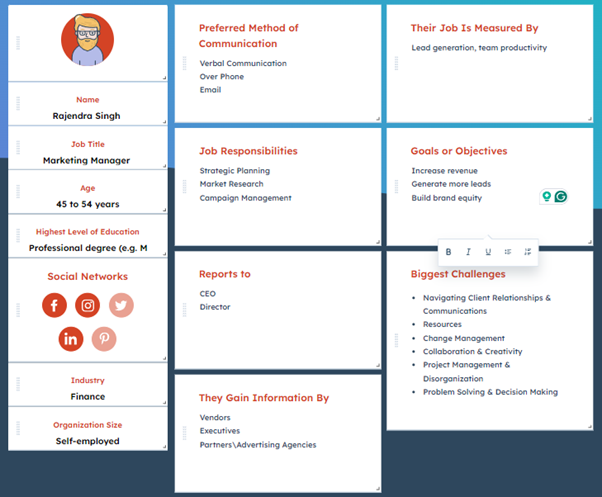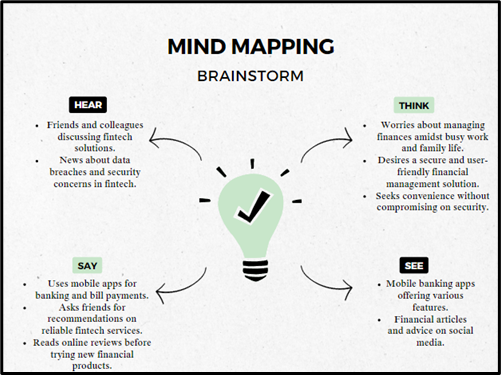$20 Bonus + 25% OFF CLAIM OFFER
Place Your Order With Us Today And Go Stress-Free
INTEGRATION OF INFORMATION SYSTEM MANAGEMENT AND INDUSTRY TECHNIQUES FOR GIVERLY
In the evolving landscape of the business environment, Giverly stands as a new-age fintech lifestyle company which focuses on the community. This fintech company was incorporated on May 25 in the year 2022. Giverly is known as a Cashback Charity platform which transforms monetary transactions into an understandable donation for solving various monetary issues in India (Giverly. in,2024). Design Thinking refers to a non-linear process which is iterative and emphasises the integration between users and the designers.

Figure 1: Standford Design Thinking Diagram
(Source: Self-developed)
In the context of Giverly, This Standford Design Thinking assists this company in fostering a user-centric approach to solving problems. It started by putting emphasis on the user preferences and their pain points within the financial services. The Ideation process helps Giverly with creative solutions by considering both desirability and feasibility. The prototype assists in rapid testing which helps to meet the changing needs of the Giverly users.
Goals and objectives: The main goal of this project is to develop and implement excellent and innovative solutions which align with the industry practices.
The key objectives are as follows:
● To identify the main pain points of the financial services of Giverly
● To design a user-specific solution framework through navigating the information system and management techniques
● To deliver a holistic business solution that increases Giverly’s competitive advantage
The main exclusions are as follows:
1. Solutions which are not aligned with Giverly’s strategic goals
2. Complicated technologies that lack implementation feasibility
3. Non-financial companies which are unrelated to the fintech
The main constraint is the budget limitation for the overall development. Along with this the integration challenges with the existing system and infrastructure also act as a potential barrier. Additionally, time constraint for the project completion within the trimester is also a considerable issue.
The main assumptions are:
1) Availability of the necessary resources
2) Stakeholders' commitment to support and implement the required solutions
3) Continuous feedback and cooperation from users of Giverly
● Implementation of the plan, timeframes and required resources
● Comprehensive analysis of the current opportunities and issues in Giverly
● Documentation of final report findings, feedback and recommendations from Giverly’s clientele
| Stakeholders | Roles |
| Senior management | To approve project scope and provide strategic direction |
| IT Department | To provide Support and implement technical solutions aligned with the information system management principles |
| Operation Team | To provide insights into the current process |
| External Consultant | To provide industry expertise and best practices |
| Customer Service Team | To offer feedback of the user's experiences and customers' issues |
| Users and Clients | To provide feedback through validation and testing |
| Stakeholders | Recommendations |
| IT Department | Implement and integrate new process |
| Operational Team | Adopt new solutions |
| External Consultant | Coordination between various consultancy |
| Customer Service Team | Training and Support to the servicing teams |
| Investors | Communicate and justify the investment in new solutions |
The stakeholders who are involved in the Giverly's expansion into the UAE involves the executive team who seeks the researched data for strategic decisions. Various suppliers such as Sugar Cosmetics provide support to the crypto transactions and the operations conducted within team coordinating across the local settings. The regulatory authorities ensure the compliance, the technological team maintain the global systems and the customers drives the revenue through charity transactions. Interests of each and every stakeholder align with the goal of Griverly to expand its market reach and ensure its operational success in the UAE.
Empathise refers to a mechanism which helps in understanding and sharing the feelings of the users of a particular company. This provides assistance to foster in-depth user understanding and deeper user insights along with their requirements (Packard & Burnham, 2021, P. 106076). It includes both the business and user perspectives of the Giverly company.
The maximum number of users want uninterrupted and simplified financial services. They are conscious about the adoption of new technologies without the definition of their benefits or track records. Individual customers seek the security and privacy in the fintech landscape to safeguard their sensitive financial information.
In the context of a business perspectives, the concerned company aimed to increase their operational efficiency by providing uninterrupted processes. They provide value to regulatory compliance with the industry regulations to ensure credibility and trustworthiness. They try to incorporate innovative solutions to differentiate themselves from the other marketers and gain more competitive advantage.

Figure 3: Empathy Honeycomb Model
(Source: Design-thinking. in,2023)
The customer persona of a company stands as a representation of the customers who purchase a concerned company’s product or services (Russo et al. 2021, p. 110). Visualisation of a customer persona enables the businessman to recognise the ideal customer for their business. This further helps them to understand customer preferences and make decisions accordingly to generate more leads.

Figure 4: Customer Persona for Customer 1
(Source: Self-developed)
The first customer is a marketing manager who seeks to incorporate efficiency tools for managing the campaigns and budgets. The main aim is to maximise the return on investment and revenue. They provide a valuation to the clear and concise data analytics for strategic decisions and uninterrupted integration with the existing process. They mainly put emphasis on user-friendly interfaces for conducting effective campaigns.

Figure 5: Customer Persona for Customer 2
(Source: Self-developed)
The second customer is a software engineer who provides a valuation of the efficient and understandable solutions which integrate the seamless process in the existing workflow. The second customer requires a holistic security measure and seamless performance metrics. A concise and clear documentation along with technical support provides support in the optimisation of the software performance.
An empathy map for a specific company refers to a collaborative technique which is used for gaining an in-depth insight into the company’s customers (Cairns et al. 2021, p. 144). The empathy map represents the feelings, behaviours, requirements and preferences of a customer, a group of consumers or a specific customer segment.

Figure 6: Empathy Map for Customer 1
(Source: Self-developed)
| Pain Points |
|
| Gains |
|

Figure 7: Empathy Map for Customer 2
(Source: Self-developed)
| Pain points |
|
| Gains |
|
The above customer persona and empathy map provide information about two different customers belonging to different sectors. The first customer is a marketing manager who focuses significantly on hearing suggestions from friends and discussing with them about data security and protection. This underlines his concerning behaviour. He always worries about the management of financial works and the formality of life which limits his reliability in balancing work life and personal life.
Omni connections for Giverly Fintech include the uninterrupted integration process across different platforms such as mobile, web and holistic cybersecurity measures. It involves the personalised user experience through using AI-driven techniques and comprehensive scalability. This connectivity ensures the seamless service delivery process along with maintaining user satisfaction in the dynamic landscape of the fintech industry.
Stakeholders' requirements are considered a define the decisions about the goals, requirements and objectives of the stakeholders. The MoSCoW method is recognised as a well-known prioritisation technique to manage requirements (Rozin, 2023, p.360).
| Activities | Stakeholders requirements |
| Must have | They have to implement seamless cybersecurity measures to safeguard user data and ensure regulatory compliance. They also have to develop an understandable user experience across various platforms to provide ease of use. |
| Should have | Giverly should integrate the automation process to maintain a streamlined operational efficiency. |
| Won’t have | They could utilise AI-drive technology to offer personalised financial recommendations |
| Could have | They have to avoid over-complicated solutions which hinder usability without clear and conscious opportunities for the stakeholders. |
The customer journey map refers to a visual representation of the stages through which customers go through while interacting with a specific company. The customer journey map highlights the requirements, perceptions and procedures of the customers throughout their relationship and interaction with an organisation (Patti, 2020, p. 2400). It includes five segments such as Awareness, Consideration, Conversion, loyalty and advocacy.

Figure 8: Customer Journey Map
(Source: Self-developed)
Giverly Fintech company stands as an authoritative service-providing organisation that focuses more on the modernisation of financial services. This further assists in fostering the competitive advantage and increasing customer demands. The present system lacks the required efficiency which poses significant challenges in the delivery of the uninterrupted user experience and maintenance of holistic cybersecurity (Giverly. in,2024).
There exists a crucial need for the integration of the advanced information system with the industry's best practices to evaluate operational effectiveness and ensure regulatory compliance. It is necessary for the Giverly to navigate the complications to form the required solutions while meeting the needs of the diverse range of customers.
Analysing the above report, it can be concluded that Giverly Fintech can able to fulfil its commitment by leveraging the aspects of its Stanford Design Thinking framework, customer persona and empathy map. The Giverly company have to focus on the stakeholder’s requirements by analysing the multifaceted aspects of the Giverly’s user segment with the help of MoSCoW or various maps. This helps this company to implement innovative solutions and increase operational efficiency within the competitive market terrain.
Cairns, P., Pinker, I., Ward, A., Watson, E., & Laidlaw, A. (2021). Empathy maps in communication skills training. The clinical teacher, 18(2), 142-146. https://doi.org/10.1111/tct.13270
Design-thinking.in,2023. HONEYCOMB MODEL Retrieved from: https://giverly.in/aboutUs, [Retrieved on: 04.07.2024]
Giverly.in,2024. ABOUT GIVERLY Retrieved from: https://design-thinking.in/honeycomb%2Fdouble-diamond, [Retrieved on: 04.07.2024]
Packard, M. D., & Burnham, T. A. (2021). Do we understand each other? Toward a simulated empathy theory for entrepreneurship. Journal of Business Venturing, 36(1), 106076. https://www.sciencedirect.com/science/article/pii/S0883902620306844
Patti, C. H., van Dessel, M. M., & Hartley, S. W. (2020). Reimagining customer service through journey mapping and measurement. European Journal of Marketing, 54(10), 2387-2417. https://www.emerald.com/insight/content/doi/10.1108/EJM-07-2019-0556/full/html
Rozin, V. (2023). The Study of Thinking in the Moscow Methodological Circle. Psychology. Journal of Higher School of Economics, 20(2), 354-369. 10.17323/1813-8918-2023-2-354-369
Russo Spena, T., D’Auria, A., & Bifulco, F. (2021). Customer insights and consumer profiling. Digital Transformation in the Cultural Heritage Sector: Challenges to Marketing in the New Digital Era, 95-117. https://link.springer.com/chapter/10.1007/978-3-030-63376-9_5
Are you confident that you will achieve the grade? Our best Expert will help you improve your grade
Order Now










